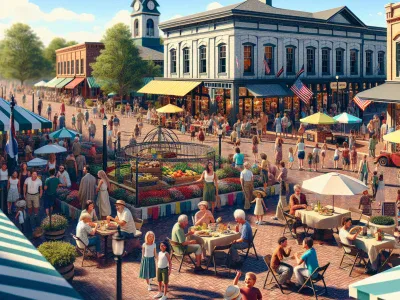Town vs Village: Exploring Key Differences in Lifestyle, Opportunities, and Environment
Picture this: the hum of bustling streets, neon lights flickering against a midnight skyline, and the constant rhythm of city life. Now contrast that with the soft rustle of leaves, the scent of fresh earth after rain, and mornings greeted by birdsong in a quiet village. Both worlds offer unique charms, but they couldn’t be more different in pace and lifestyle. which setting truly suits your personality? Towns promise convenience and endless opportunities while villages offer tranquility and a deeper connection to nature. The choice between these two lifestyles isn’t just about where you live—it’s about how you live. Each has its own set of perks and challenges that shape daily life in unexpected ways.
Town Vs Village: An Overview
Towns and villages differ significantly in their structure, lifestyle, and amenities. A town typically features a higher population density, advanced infrastructure, and diverse economic opportunities. In contrast, a village is characterized by open spaces, smaller communities, and an agrarian-based economy.
Lifestyle Differences
In towns, people often lead fast-paced lives driven by work schedules and social activities. Examples include commuting to offices or attending urban events. Villages offer a slower pace of living with routines centered around farming or local crafts. For instance, mornings in villages might begin with tending livestock or cultivating crops.
Infrastructure Comparison
Towns provide modern facilities like hospitals, schools with specialized education programs, and well-connected transportation systems such as subways or buses. On the other hand, villages often rely on basic amenities; access to healthcare can require traveling to nearby towns.
Social Dynamics
Towns promote individualism due to their diverse populations where personal networks are vast but less intimate. Villages foster close-knit relationships within small groups where everyone knows each other personally—celebrations like harvest festivals are shared community experiences.
| Aspect | Town | Village |
|---|---|---|
| Population | Densely populated | Sparsely populated |
| Economy | Service/industrial sectors | Agriculture-focused |
| Pace of Life | Fast | Slow |
| Infrastructure | Advanced | Basic |
You may find that your preferences align more with one environment than the other based on these differences.
Lifestyle Differences
Town and village lifestyles differ significantly, shaping daily routines, social interactions, and overall quality of life. These differences reflect both the challenges and benefits inherent to each environment.
Urban Convenience Vs Rural Simplicity
Urban areas offer a range of conveniences like advanced transportation networks, high-speed internet access, and diverse shopping centers. For example, you can find grocery stores open 24/7 or rely on ride-hailing apps for quick commutes. In contrast, villages prioritize simplicity with limited but essential amenities. You might grow your own vegetables or barter goods within the community instead of purchasing them.
While towns focus on efficiency and accessibility, rural settings foster self-sufficiency. Owning land for farming or raising livestock is common in villages but rare in urban centers due to space constraints. The pace differs too; town residents often juggle busy schedules while villagers embrace slower routines influenced by nature’s cycles.
Social Life And Community
Towns typically host diverse populations with varying cultural backgrounds. This diversity enriches social experiences but may lead to more individualistic lifestyles as relationships become task-oriented or transient. Work colleagues or acquaintances often replace close-knit bonds seen in smaller communities.
In villages, communal ties play a central role in daily life. Celebrations like harvest festivals involve everyone and strengthen mutual support systems during hardships. For instance—when someone builds a new house—the entire village might contribute their skills to help complete it faster.
Economic Opportunities
Towns and villages differ significantly in the scope and type of economic opportunities they offer. These differences shape how individuals earn their livelihoods and influence community development.
Job Availability In Towns
Towns provide diverse employment options across multiple sectors, including retail, education, healthcare, hospitality, and technology. Corporate offices, factories, and service-based industries create positions requiring varying skill levels. For example, a town might host IT companies needing software developers alongside hotels employing front-desk staff.
Public transportation systems also support job accessibility by reducing commute times. This infrastructure fosters career growth by connecting workers to urban centers or neighboring towns with broader opportunities.
But, competition for these jobs can be intense due to higher population densities in towns. You may find that specialized qualifications give candidates an edge in securing desirable roles.
Agricultural Roots In Villages
Villages rely heavily on agriculture as the primary source of income for most residents. Farmers cultivate crops like rice or wheat depending on regional conditions while others rear livestock such as cattle or poultry for milk and meat production.
Seasonal work patterns dominate rural economies because planting and harvesting schedules dictate activity peaks. Artisanal crafts like weaving or pottery often supplement farm incomes during off-seasons; handmade goods are sometimes sold in nearby markets or exported to urban areas.
Limited access to advanced tools and technology affects productivity levels compared to mechanized farming methods used elsewhere. Nonetheless, villagers frequently adopt sustainable practices that preserve local ecosystems while ensuring long-term resource availability for future generations.
Environment And Living Conditions
Towns and villages differ significantly in their environmental aspects and living conditions, shaping distinct lifestyles for their inhabitants. These differences influence daily life, health, and overall well-being.
Noise And Pollution In Towns
Towns typically experience higher noise levels due to traffic congestion, construction activities, and population density. Cars honking during rush hours or machinery operating at construction sites contribute to constant background noise. Air pollution is another concern as vehicle emissions and industrial outputs increase particulate matter in the atmosphere. According to the World Health Organization (WHO), urban areas often exceed recommended air quality thresholds, impacting respiratory health over time.
Water contamination can also be a problem where untreated sewage mixes with water sources, especially in rapidly growing towns without proper waste management systems. For example, in cities like Los Angeles or Mumbai, smog frequently blankets the skyline during peak pollution seasons.
Waste disposal challenges are prevalent too. While recycling initiatives exist in some towns, garbage accumulation occurs when infrastructure can’t keep up with rising waste production rates linked to consumerism.
Natural Serenity In Villages
Villages offer cleaner air due to minimal industrial activities and fewer vehicles on the roads. Open spaces filled with greenery not only enhance oxygen levels but also provide habitats for diverse flora and fauna species—a stark contrast from urban environments dominated by concrete structures.
Noise pollution is rare except for natural sounds like birds chirping or occasional farming equipment use. This quiet ambiance contributes positively to mental health by reducing stress levels associated with urban commotion.
Agricultural practices dominate village landscapes where organic farming methods support sustainable ecosystems compared to urban agriculture’s reliance on synthetic chemicals. Fresh produce grown locally often reaches homes directly without long supply chains that diminish nutritional value over time.
Education And Healthcare
Education and healthcare differ significantly between towns and villages, shaping the quality of life for their residents.
Access To Facilities In Towns
Towns offer a wider range of educational institutions and healthcare facilities. Schools in towns include public, private, and international options that provide diverse curricula like STEM-focused programs or arts-based learning. For example, urban schools often feature advanced laboratories and extracurricular activities such as robotics clubs or theater productions. Similarly, colleges and universities in towns attract students with specialized courses unavailable in rural areas.
Healthcare services in towns are more accessible due to the presence of hospitals, clinics, diagnostic centers, and pharmacies. Specialized medical care is readily available through facilities equipped with modern technology like MRI machines or ICUs. Emergency response times tend to be faster because ambulance networks are well-established within urban infrastructure. Towns also host health awareness campaigns addressing issues like diabetes management or mental health support.
Challenges Faced In Villages
Villages face challenges due to limited access to education and healthcare resources. Schools often lack essential infrastructure such as libraries or computer labs; many rely on multi-grade teaching where one teacher handles multiple classes simultaneously. This constraint affects students’ ability to compete academically with town-educated peers. Some children travel long distances daily for better schooling opportunities.
Healthcare systems in villages struggle with shortages of doctors, nurses, and medical supplies. Basic treatments are provided by community health workers instead of trained specialists. Residents frequently travel to nearby towns for complex medical procedures or specialist consultations when village facilities prove inadequate. Seasonal diseases like malaria further strain these limited resources during outbreaks.
Conclusion
Choosing between a town and a village eventually depends on your values, priorities, and lifestyle preferences. Each offers its own unique benefits and challenges, shaping how you live and interact with the world around you.
Whether you’re drawn to the convenience and opportunities of urban life or the peace and simplicity of rural living, it’s important to consider what aligns best with your personal needs. Both environments provide distinct experiences that can enrich your perspective in different ways.
Wherever you decide to call home, embracing the strengths of your chosen setting will help you make the most of your surroundings while staying true to what matters most to you.
- King vs Queen Size Bed: An In-Depth Comparison for Your Perfect Mattress Choice - October 29, 2025
- Krill Oil vs Fish Oil: Key Differences, Benefits, and Choosing the Right Omega-3 Source - October 29, 2025
- Understanding the Difference Between OT and PT: A Comprehensive Guide - October 29, 2025







